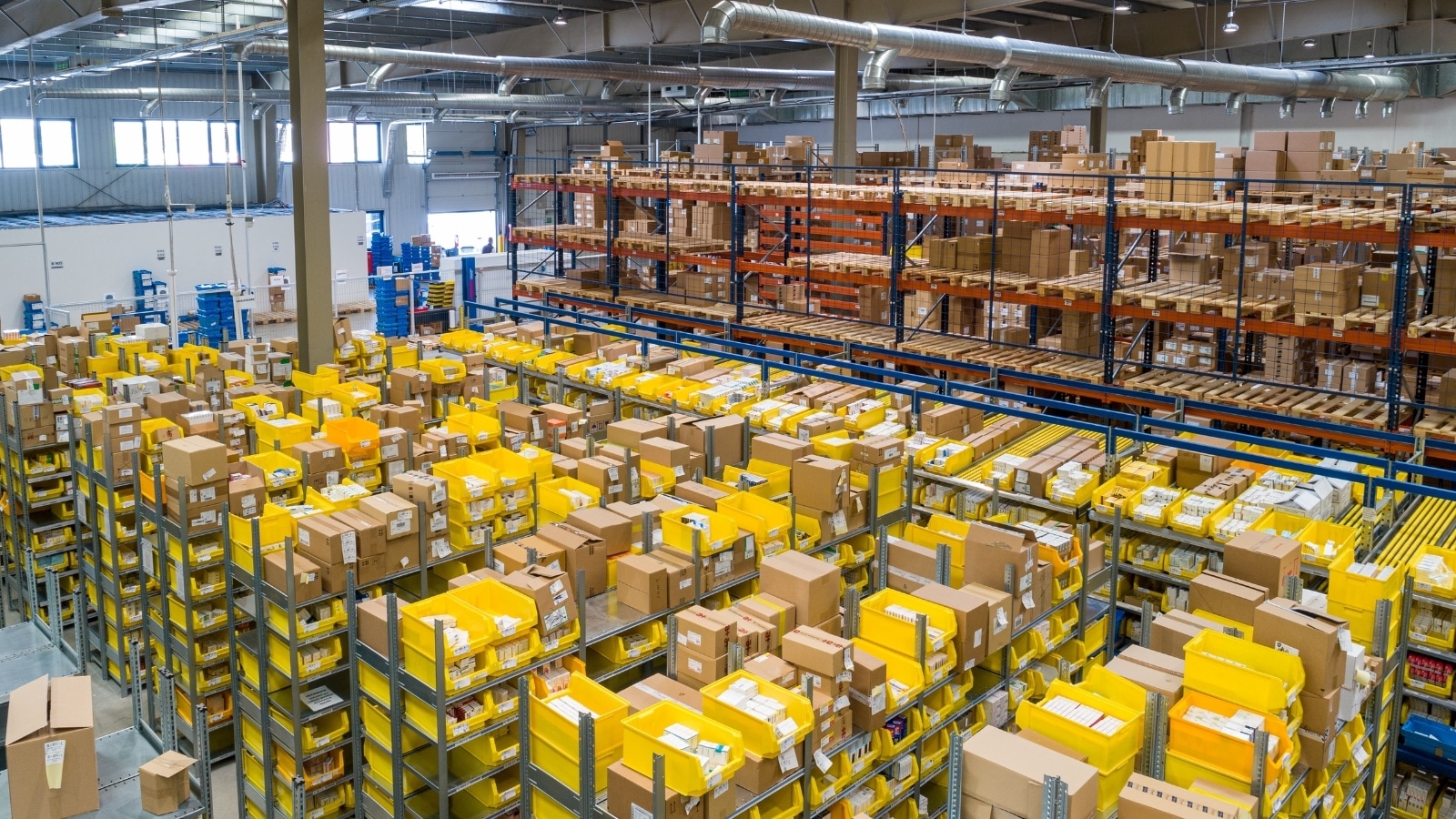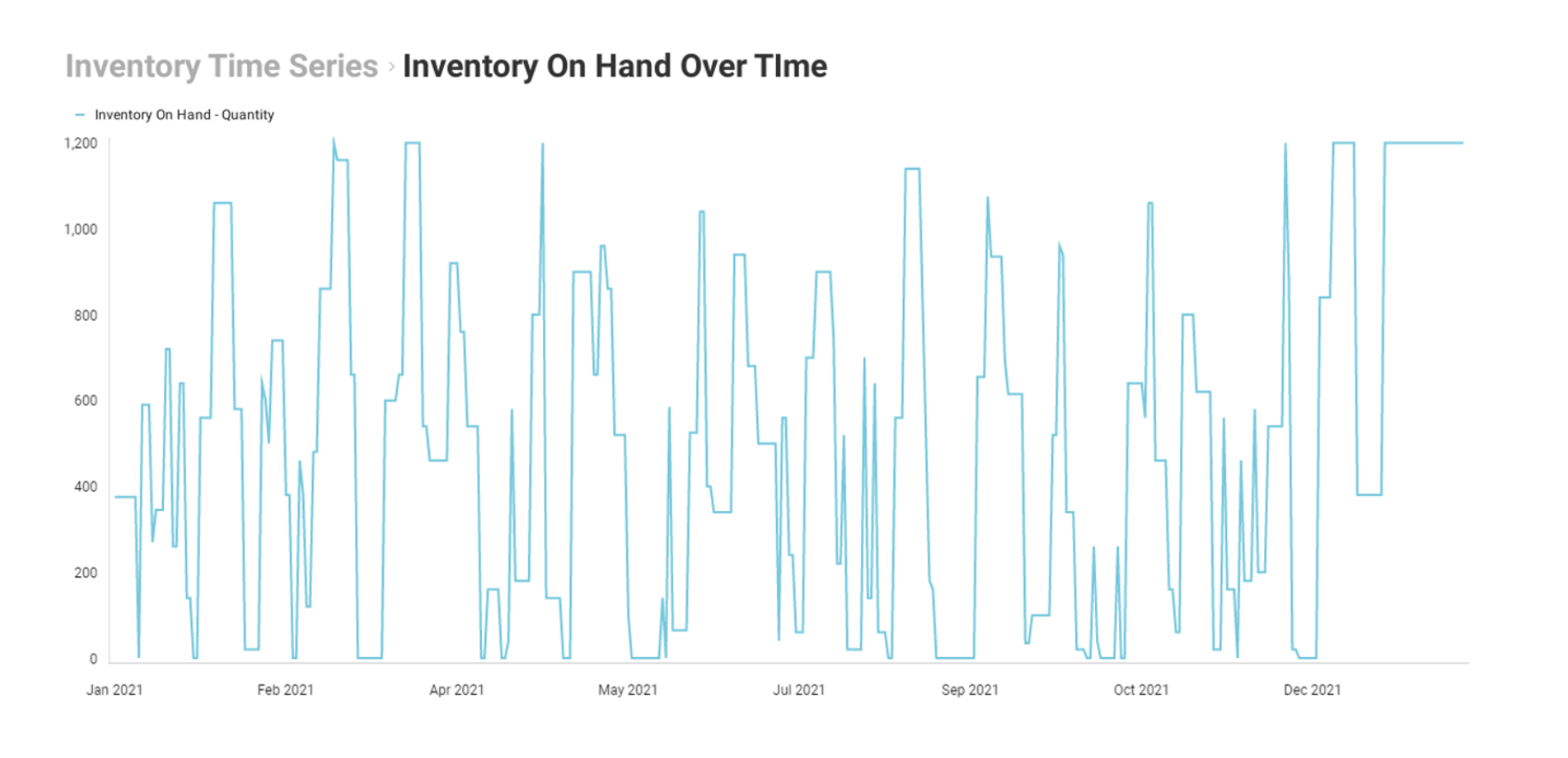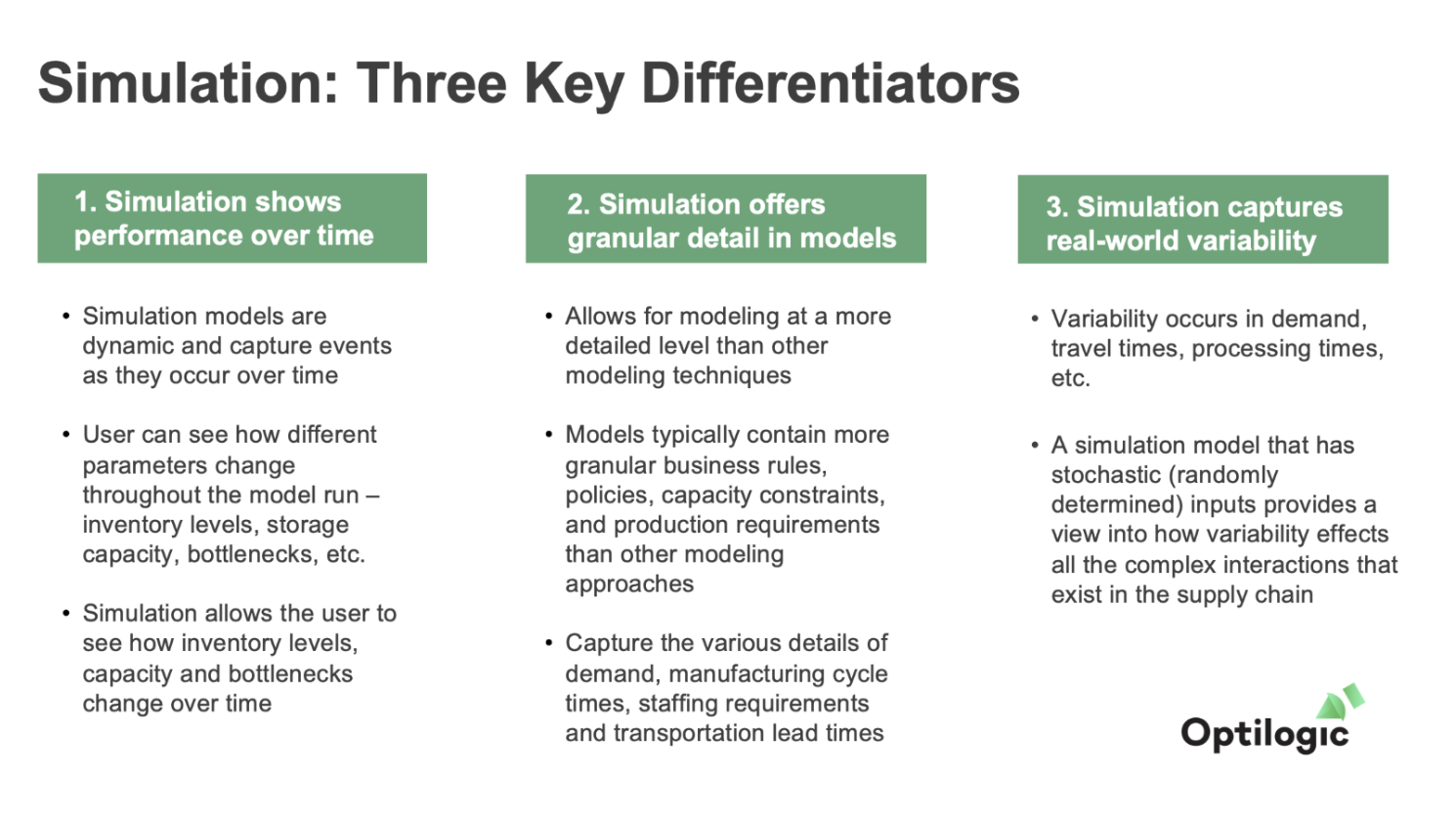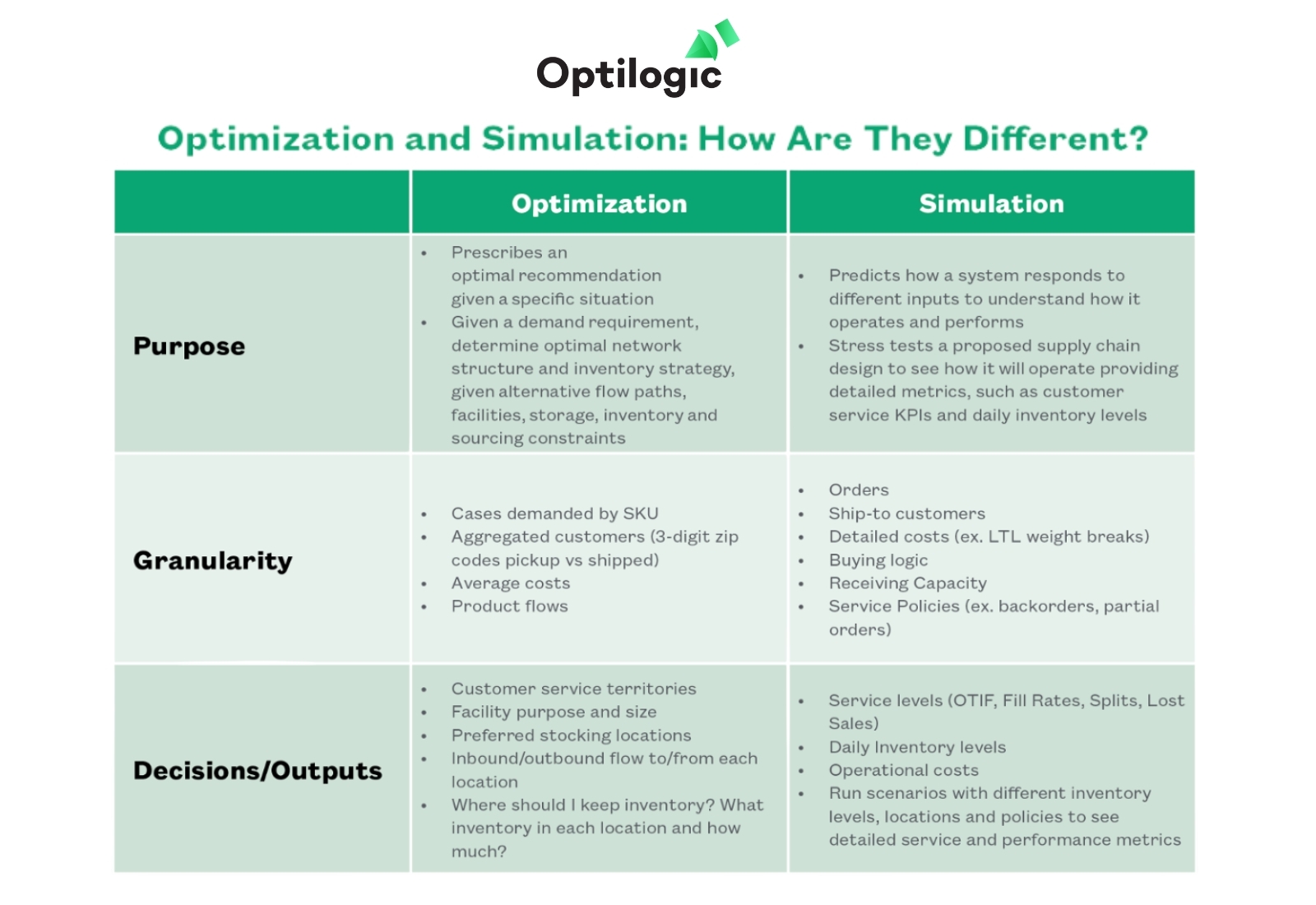Blog
Supply Chain Simulation Explained
PUBLISHED ON:
May 23, 2023

Subscribe to Receive the Latest Supply Chain Design Resources
Supply chain simulation is the most granular modeling technique. This preferred method for service level analysis shows how business rules, policies, product requirements, etc. impact demand, manufacturing cycle times, staffing requirements, transportation lead times, and more. These insights can be instrumental for a multi-tiered supply chain’s inventory strategy.
If you’re a bit intimidated by the concept of simulation, we’ve got you covered. Read our supply chain simulation primer to learn the basics of simulation and how it brings unique value to strategic supply chain design.
In This Article
1. What Is Supply Chain Simulation?
2. The Supply Chain Simulation Process
3. When to Use Supply Chain Simulation
- Inventory optimization
- Inventory policy setting and testing
- Stocking locations, levels, and reorder parameters
- Predicting the impact of new product introductions
- Altering distribution channels or logistics
- Assessing the performance of suppliers and other partners
- Planning for demand variability
- Proactive risk management
- Supporting sales and operations planning (S&OP) process
- Connecting network design to planning and execution processes
4. Benefits of Supply Chain Simulation
- Identify optimization opportunities
- Maintain agility and resilience
- Reduce risk in the planning process
- Capture system dynamics
5. Supply Chain Simulation vs. Optimization
——————————————————-
What Is Supply Chain Simulation?
Supply chain simulation creates realistic scenarios of the supply chain that help businesses make intelligent, data-backed decisions to improve operations. Simulation allows businesses to mitigate risk and strategize and test potential optimizations in a low-stakes environment for every stage of the supply chain. Tweaks can be made to suppliers, transport routes, warehouses, manufacturing processes, distribution channels, customer support, and more.
The simulation process relies on data collection, model and scenario development, test execution, and analysis to bring the simulation results as close to the real-world supply chain as possible.
Supply chain simulation models are unique in how deeply they understand the inner workings and behavior of the systems they are modeling. They’re uniquely adept at evaluating strategies for operating the system as it evolves over time. These models are typically stochastic, meaning they account for the randomness and variability of the real system in their analysis. Incorporating random outlier events allows the system to predict and analyze inventory outages and overages, bottlenecks, bullwhip effects, etc.
While often misconstrued, scenario modeling and simulation modeling are not synonymous. Optimization scenario modeling is a mathematical model that solves an equation or objective function. It does not simulate the behavior of the system.
Simulations are dynamic models. They capture system performance over time, which provides a clear picture of the interactions and dependencies between all elements of the system. This allows the user to view how inventory levels, storage capacity, and bottlenecks ebb and flow as the model runs.
The Supply Chain Simulation Process
- First, supply chain data and policies on transportation costs, lead times, and inventory levels are collected. This data will become the foundation of the virtual model.
- The model development stage forms a virtual representation of the supply chain process and all of its components.
- Once the model is ready to handle real-world simulations, scenario development takes place. This is where you identify what changes you want to make and what aspects of the supply chain those changes will impact.
- Last up is the test execution phase. This is when the simulations are run and the results are analyzed.
When to Use Supply Chain Simulation
Simulation models can be instrumental in designing new supply chains and optimizing current ones.
Supply chain simulation gives users the ability to predict and mitigate the effects of significant disruptions via scenario analysis. Scenario analysis simulations provide answers to pressing “what if” questions through data-driven trending and analysis.
Businesses can use what-if scenario analysis simulations to predict change and prepare for short and long-term market shifts. Here are some common instances where implementing a simulation model can improve supply chain performance with little to no risk:
Inventory optimization
Supply chain simulation takes traditional inventory optimization to the next level. Organizations can use traditional optimization to answer common questions like where stocking locations should be located throughout the network, ideal stocking levels per location, and what policies should decide when and how much inventory to reorder at each location. Simulation goes one step beyond answering these questions by providing insights that can improve overall inventory health in the long term.
Inventory policy setting and testing
Policies that govern the behavior of the system influence inventory throughout the entire network. Simulation models that test postponement processes, safety stock policies, and consolidation/shipping policies complement optimization in design analysis, providing a clear understanding of how each policy impacts the end-to-end supply chain.
Stocking locations, levels, and reorder parameters
Simulation models can be used to test inventory parameters like replenishment points, order amounts, and inventory review periods. The model produces KPIs like detailed service levels, On time in full (OTIF) order metrics, asset utilization, and operating costs. This method bases optimal inventory policies and parameters on multiple KPIs in addition to the traditional aggregated cost analysis, creating a more holistic analysis of system performance.

Predicting the impact of new product introductions
Launching a new product or service can be risky. Ideally, you don’t want to invest a great deal of time and money into an unproven product. You have to consider consistent factors like your brand identity, production capability, profitability, and the needs and preferences of your target audience. Then there are inconsistent factors to account for, such as industry trends, seasonality, and what your competitors are doing. This is where simulation changes the game. Businesses can use supply chain simulation to gauge how the supply chain will react to potential new products and services.
Even when you develop a solid group of products that align with your brand, audience, and strategy, there will still be bad apples among the group that just aren’t profitable.
Product mix analysis is a supply chain simulation application that can help you identify the most profitable product mix before you invest time and money in production.
Altering distribution channels or logistics
Switching up distribution channels or logistics partners can be detrimental to a supply chain’s stability. Before making a decision, organizations can run simulations to assess how the changes may impact the supply chain as a whole. This gives organizations the information necessary to make smart decisions, reduces risk, and facilitates smooth, informed transitions.
Assessing the performance of suppliers and other partners
Businesses can use supply chain simulation to evaluate partner performance and identify areas for improvement. Simulating these scenarios enables businesses to make informed, objective decisions about what suppliers, transportation providers, and other partners to utilize to avoid bottlenecks, risks, and decreased productivity. These simulations can also identify partner optimization opportunities that reduce costs and improve customer satisfaction.
Planning for demand variability
Supply chain simulation can be used to evaluate the impact of demand variability on inventory levels. Demand variability has the potential to shake up complex supply chains. Simulation allows businesses to test various demand scenarios and identify the optimal inventory levels that meet customer needs while minimizing over/understocking.
Simulating different levels of demand is also helpful for capacity planning. Organizations can determine how much capacity they need to meet potential demand without falling victim to over or underproduction.
Proactive risk management
When whispers of a potential supply chain disruption surface, organizations can run a simulation to understand how their supply chain will be impacted if the risk comes to fruition. Users can then create data-backed contingency plans for each potential outcome. For example, a potential disruption may require a temporary change in inventory policies.
Identifying, quantifying, and mitigating risk is key to building resilience and increasing metrics like service levels and profit margins.
Supporting sales and operations planning (S&OP) process
Supply chain management simulation can support S&OP processes. Analysts can evaluate capacity, stocking, demand, and sourcing policy changes across time periods.
The simulation helps users understand metrics like cost to serve, margin to serve, order service by customer, and overall capacity utilization across facilities, lines, and/or warehouses. Because supply chain simulation uses SKU level and order level detail, the simulation provides executive insight into KPIs for demand and supply scenarios typically run during S&OP processes.
Connecting network design to planning and execution processes
Today’s industry leaders are realizing that supply chain network design processes should not exist apart from enterprise planning and execution systems. Connecting the two allows recommendations identified in the strategic design scenario analysis to seamlessly transfer to planners and schedulers.
Simulation prioritizes what pieces of supply chain designs must be implemented first for the best results. It shows how a new policy might affect the planning and execution process. Through this process, planners, managers, and executives can see the “to-be” state prior to implementation. This approach can be utilized for product launches, moving or adding suppliers to key BOM elements, or altering transport policies.
Benefits of Supply Chain Simulation
Identify optimization opportunities
Supply chain simulation can identify inefficiencies and opportunities for optimization. By simulating the entire supply chain, organizations can observe bottlenecks, delays, and other inefficiencies that may be impacting their performance. With this information, users can create strategies that mend the issue and create a more efficient supply chain.
Simulation enables a more accurate level of service performance than optimization modeling alone. Combining detailed service metrics and financial performance data strengthens the model output.
Using supply chain simulation to optimize the supply chain enhances the ability to meet customer demand by improving service metrics like product availability and delivery times, which boosts customer satisfaction.
Optimizing safety stock and lead times also allows organizations to reduce inventory levels without compromising product availability. The assets (monetary, storage, labor) required to keep backup inventory can be reallocated to increase profit margins.
Supply chain simulation also gives users the ability to model variability. They can then choose the correct inventory policy and targets informed by stochastic demand rather than simplified, aggregated demand.

Maintain agility and resilience
Supply chain simulation enables organizations to increase their supply chain’s agility and resilience in the face of potential disruptions. Users can simulate potential scenarios on the horizon and develop contingency plans. Disruptions are inevitable, but supply chain simulation enables organizations to minimize the impact disruptions have on operations, customers, brand reputation, and the organization’s bottom line.
Reduce risk in the planning process
What-if simulations allow users to test various alternatives before carrying out any new plans. Thanks to the way they account for the element of randomness missing from most modeling methods, these simulations paint the most accurate possible picture of how the scenario will play out.
Users can visualize all potential outcomes before making any decisions. Cost/benefit analysis can be carried out for each outcome. Because users now have foresight, they can devise tactics for risk mitigation to compensate for negative outcomes.
Capture system dynamics
Probability distribution allows users to model unexpected events in specific sections of the supply chain. From the simulation results, users can observe and understand how certain events in key areas impact the supply chain as a whole.
Supply Chain Simulation vs. Optimization
Supply chain optimization is designed to prescribe an optimal recommendation for a specific situation. Optimization takes a demand requirement, alternative flow paths, facilities, storage, inventory, and sourcing constraints and determines the optimal network structure and inventory strategy. It is a mathematical equation in this way.
Simulation, on the other hand, predicts how the system will respond to inputs with the ultimate goal of understanding how the supply chain operates and performs. Simulation stress tests the supply chain design to observe how it will operate. Simulation results include detailed performance metrics.
Where optimization answers the “what”, simulation tells us “why”. When users can identify what policy is best and why that is the case, both the model and the analyst get more credibility. The resulting recommendations carry more weight, which can be powerful when implementing them requires persuasion.

What is simulation optimization?
Simulation optimization optimizes a specific function based on the outputs of the simulation model. It identifies the best simulation parameters to optimize a specific function by running multiple simulation scenarios. This combination of simulation and optimization provides an accurate representation of the supply chain system on which users can base inventory optimization and strategic planning, which creates a more accurate approach to inventory optimization and strategy as a whole.
Try Cosmic Frog Supply Chain Simulation Software, Risk-Free
Supply chain simulation software empowers organizations to understand and optimize the most complex systems. From that understanding stems informed decision-making, demand forecasting, and risk management strategies.
With the right software, you can combine the power of global supply chain management simulation and optimization to manage supply chain challenges, reduce costs, and improve customer satisfaction.
Cosmic Frog is the only supply chain network design platform that combines optimization, simulation, and risk engines so can identify the weak and strong points in your network, improve service levels and minimize risk, and stay prepared for disruption scenarios headed your way.
With Cosmic Frog, you can tackle:
- Supply chain network design
- Inventory policies
- Greenfield analysis
- Sourcing and procurement
- Distribution and logistics
- Risk management
- Supply chain sustainability
- Reverse logistics
… plus a whole lot more.
Grow Your Knowledge
Rethink Redesign: 8 Things Supply Chain Execs Need to Know in 2024
Discover the essential insights for supply chain executives in 2024 as we delve into the latest trends, innovations, and strategies reshaping the industry. Explore this insightful ebook, authored by Optilogic Founder Don Hicks and Maria Villablanca, founder of Villablanca Consulting and Future Insights Network and Co-founder of Transform Talks Podcast.
Optilogic Hosts OptiCon 2024: The Supply Chain Design Design Event of the Year
The leading supply chain design software innovator Optilogic announces its annual user conference, OptiCon 2024, featuring supply chain design solution training, focused breakout sessions and customer case studies from industry giants Coca-Cola, Gerdau, and Whirlpool.
How Supply Chain Design Addresses the Global Impacts of Port Congestion
Explore how supply chain design tackles the pressing issue of global port congestion, delving into strategies, technologies, and innovations that optimize logistical pathways, mitigate disruptions, and ensure smooth operations in the face of evolving challenges.




